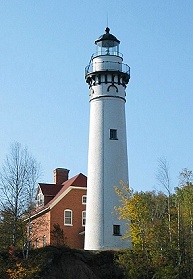The Outer Island Saga
O.K. Hall's First Day At Work
 Orator K. Hall was feeling a distinct sense of relief. It was his first
day on a challenging new job, and things seemed to be going his way. Orator K. Hall was feeling a distinct sense of relief. It was his first
day on a challenging new job, and things seemed to be going his way.
This was no ordinary job that Hall was starting: he had managed to secure
appointment as keeper of the new light station on Outer Island. Though
lacking lighthouse experience, he now found himself in charge of one of
the most important lights on Lake Superior.
Construction had begun on the lighthouse more than a year before, and
on this day, September 17, 1874, work was nearly done. The elegant tower,
designed not just for utility, but with grace and beauty in mind, rose
to its full height of eighty feet. With nearly fifty more feet of elevation
gained by its blufftop setting, the large third-order Fresnel lens would
soon cast its beam nineteen miles across the lake. More than just a guidepost
to a single harbor, the Outer Island light would become a key reference
point for navigation on Lake Superior.
O.K. Hall would have to learn his duties on the job, and he'd have to
do it quickly: once the construction crew was finished with last-minute
chores, they'd pile into a boat and leave Hall to run the station on his
own. From then on, twenty-two miles from the mainland, lacking any means
of contact with his superiors or fellow lightkeepers, Hall would have
to figure things out on his own.
Although Hall would have an assistant to share the work, the fact offered
little comfort. John Drouillard had no more experience than his boss did.
Later on, Hall would recall that he hired Drouillard with reluctance;
wages for the position were low, and he could not seem to find an experienced
man who would take the job.
Good luck seemed to be with O.K. Hall on his first day, though. In the
morning, at Bayfield, just as he got ready to load his household goods
onto a sailboat for the journey to Outer Island, he encountered three
workers who were heading out to his lighthouse to install the fog signal.
Forsaking the slow sailboat, he joined the crew on a steam tug, and rode
to the island in comparative speed and comfort.
On arrival, he found he'd gotten an even bigger break: Mr. Crump, the
"lampist," had just turned up at Outer Island, and was planning on staying
for several days. Crump would be able to give the new keeper expert instruction
on the workings of the beacon; as Hall noted, "I was just in time to learn
and improve all I could in running it."
Hall watched the lamp technician closely as he set up the illuminating
apparatus and adjusted the clockwork so that the third-order lens would
revolve smoothly and precisely. The lampist's skill impressed him; he
later noted, diffidently, "Mr.Crump worked diligently and completed it
in a workman-like manner with pleasure to himself and honor to the craft
- if I am any judge."
Then came an opportunity to practice trimming the wick, adjusting the
valves, and winding the clockwork so that the lighthouse would show a
clear and steady light, flashing at precise intervals. The task was not
easy, but after several hours of work, Hall finally decided he had mastered
the lamp. He recorded his accomplishment with wry pride on the first page
of the new station's logbook:
"I ran it one-half day to see if I could handle the critter. I put
on a good light, but my overflow was too great, which I remedied. After
a good deal of sweat and anxiety I conquered the kicking critter."
How did a man who found a lighthouse lamp so intimidating gain the position
of keeper at an important new light? How was it that the arrival of the
lampist and the fog signal crew came as a surprise to the man ostensibly
in charge of the station?
Evidence suggests that Hall, like many other keepers of his time, may
have secured his appointment through political influence. Though more
than twenty years had passed since the creation of the U.S. Lighthouse
Board, with its mandate to improve the administration of the lighthouse
service, the system was still infected by cronyism and patronage. Several
other less-than-qualified individuals had gotten keepers' posts in the
Apostle Islands on the strength of recommendations from prominent politicians,
and subsequent events were to demonstrate that Hall could call on influential
friends when the need arose.
If Outer Island's first keeper had indeed been handed his job as a patronage
plum, it would not be the only time the establishment and construction
of the station was sullied by questionable practices. While the early
difficulties at Outer Island were not so egregious as the misplacing of
the LaPointe light on Michigan Island, nonetheless, the station did not
have an easy birth.
Continue: A Lighthouse On The Outermost Island
|